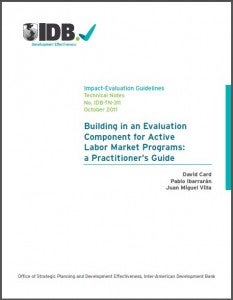 With the purpose of providing support for those in charge of overseeing evaluations, we at the Office of Strategic Planning and Development Effectiveness at the IDB are producing guidelines on selected topics and methods.
With the purpose of providing support for those in charge of overseeing evaluations, we at the Office of Strategic Planning and Development Effectiveness at the IDB are producing guidelines on selected topics and methods.
This allows non-evaluators to understand the key steps that are necessary for a credible evaluation to take place. Our latest publication is Building an Evaluation Component for Active Labor Market Programs: a Practitioner´s Guide, written by David Card, Juan Miguel Villa and myself.
This guideline emphasizes two popular evaluation methods, random assignment and difference-in-differences.
Its application goes well beyond labor market programs, and walks the reader to the necessary steps for planning, implementing and using the results of an impact evaluation.
The field of impact evaluation has grown substantially in recent years, with increasingly more micro-econometricians developing theoretical insights on how to credibly identify impacts.
While standard econometrics textbooks used to teach the basic techniques that are applied to evaluation, recent econometric books pay special attention to the identification question framed within the context of impact evaluation of projects.
Perhaps the best well known book is Mostly Harmly Econometrics by Joshua D. Angrist and Jörn-Steffen Pischke.
Another example on a more technical level is Econometric Analysis of Cross Section and Panel Data by Jeffrey Wooldridge that in its second edition includes a chapter on Estimating Average Treatment Effects. Similarly, in his intermediate microeconomics course at Berkeley, David Card includes a final lecture on Empirical Methods in Microeconomics that introduces the standard econometric techniques used for impact evaluation.
The increased emphasis on impact evaluation has also been accompanied by books that are less technical and oriented for those interested in applying the basic principles, such as Impact Evaluation in Practice by Paul Gertler, Sebastian Martinez and other experts and this Guide. Enjoy.


Leave a Reply